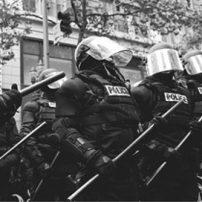
Inadequate and faulty research regarding police officer gunshot during an arrest violated the procedural part of the right to life
JUDGMENT
Chebab v. France 23.05.2019 (no. 542/13)
SUMMARY
The applicant was shoot by a police officer during his arrest. Numerous shortcomings in the investigation of the applicant’s allegations, procedural irregularities and loss of significant evidence. Long-term research of eight years. The investigation process was neither timely nor effective. Infringement of the procedural aspect of Article 2 (right to life) of the ECHR.
PROVISION
Article 2
PRINCIPAL FACTS
The applicant, Fouhed Chebab, is a French national who was born in 1976 and lives in Nancy
(France).
On 8 March 2000 a resident of Thionville called the police at about 4.30 a.m., saying that two men
were trying to break into flats in his building. Two police officers were dispatched to the scene. The
resident showed them two men sitting on a bench near the building. The police officers went to
arrest the men, and one of the officers fired a shot from his weapon, injuring the applicant on the
neck and right shoulder. An investigation by the Regional Police Department concluded that the
police officer had used his weapon in self-defence and that the applicant had threatened him with a
knife.
On 19 May 2000 the applicant was summoned to appear before the Criminal Court on charges of
intentional assault involving the use of a weapon against a person exercising public authority. On
16 January 2001 the court declared the proceedings null and void on account of the delay in
notifying the applicant of his rights. The Metz Court of Appeal upheld that judgment, adding that the
proceedings were also null and void because of the unlawful manner in which the knife had been
seized. It noted, among other points, that the various actions performed on that object had made it
impossible to reach any findings that could assist in establishing the truth, bearing in mind that the
applicant and the police officer had given entirely conflicting versions of the incident.
On 18 July 2002 the applicant lodged a criminal complaint and civil-party application concerning
offences of attempted murder, altering the state of a crime scene and assault involving the use of a
weapon by a person exercising public authority. He also submitted an expert medical report which noted, in addition to the injuries caused by the gunshot, a twenty-centimetre long hematoma on the right part of the thorax and filling of the right supraclavicular fossa. The doctor considered these injuries to be consistent with a blow sustained while the applicant was standing, and resulting in a fracture of the right clavicle. The applicant also submitted a certificate from a psychiatrist, indicating that the applicant was suffering from a post-traumatic reaction. On 17 March 2003 the public prosecutor applied to have a judicial investigation opened in respect of the police officer who had
used his weapon. Two psychiatric examinations were carried out. The first expert found that the
applicant was suffering from schizo-affective disorders; the second expert noted schizophrenic-like
psychosis with seriously disabling disturbances and also noted that the applicant was suffering from
post-traumatic stress following the incidents.
On 2 July 2010 the investigating judge discontinued the proceedings, finding that the evidence
gathered was not capable of invalidating the police officer’s version of events. The Court of Appeal
upheld the discontinuance order, observing that it was difficult to establish what had actually
happened during the arrest and that the analysis of the reconstruction of events lent weight to the
idea that the police officer had acted in self-defence. The court added that the shot had to be
deemed proportionate to the circumstances. The Court of Cassation dismissed an appeal on points
of law by the applicant.
THE DECISION OF THE COURT
Article 2
Applicability
The Court considered that the applicant had been the victim of conduct which, by its nature, had
endangered his life, even though he had survived his injuries. It held that the force used against him
by the police had been potentially lethal and that Article 2 of the Convention was applicable.
Substantive aspect
The Court noted, like the Investigation Chamber of the Metz Court of Appeal, that the investigations
had not established what exactly had happened during the applicant’s arrest. Like the national
courts, it considered, however, that the police officer called out in the middle of the night to
intervene in an attempted burglary, faced with an aggressive individual, backed up against a metal fence, could reasonably have considered that there was a need to resort to the use of his weapon in order to neutralise the threat. In those circumstances, the use of force had not exceeded what was “absolutely necessary” for “the defence of any person from violence” and particularly in order to “effect a lawful arrest”. It followed that there had been no violation of Article 2 in its substantive aspect.
Procedural aspect
The Court reiterated that the obligation to protect the right to life required that there should be an
official investigation when individuals had been killed as a result of the use of force, but also when
the force used by the police had placed an individual’s life in jeopardy.
Only an investigation into the offences allegedly committed by the applicant had been opened. It
had not been accompanied by a full medical assessment of the applicant, nor a ballistics report, nor
any analysis of the applicant’s clothing. It was only at the applicant’s initiative that, more than two
years after the incident, a judicial investigation was opened.
The Court reiterated that the authorities had to take action of their own motion and that they could
not leave it to the initiative of the victim either to lodge a formal complaint or to take responsibility
for the conduct of an investigative procedure.
The Court noted that there had been numerous shortcomings in the investigation into the alleged
offences committed by the applicant. Thus, the domestic courts themselves had noted that the
seizure of the knife had had to be set aside. The court of appeal had held that the lack of precision in
the police records made it impossible to identify the place and exact time that this knife was found
and that the various actions performed on that object had made it impossible to reach any findings
that could assist in establishing the truth. The criminal court, and subsequently the Metz Court of
Appeal, had declared the proceedings null and void on account of the delay in notifying the applicant
of his rights while in police custody. With the exception of one paragraph, the questioning of the
police officers from the BAC had been written up in absolutely identical wording. The authorities had
been unable to find the originals of the applicant’s medical imaging results, obtained on the day of
the incident. These documents would have made it possible to verify his allegations that he had
been struck on the right side of the collarbone. Other medical documents were missing and had
been unavailable for analysis. Lastly, the clothing worn by the applicant at the relevant time, seized
and placed under seal on 8 March 2000, had disappeared. The Court considered that it was for the
national authorities to ensure rigorous management of sealed material and to secure its
conservation, as this evidence contributed to the effective nature of an investigation and could
prove decisive in the subsequent proceedings.
These procedural irregularities and the loss of items of evidence which were essential for
establishing the truth had affected the adequacy of the investigation. The authorities had not taken
the reasonable steps available to them to secure the evidence concerning the incident of 8 March
2000.
With regard to the rapidity of the proceedings, the Court noted that twelve years had elapsed
between the incident of 8 March 2000 and the Court of Cassation’s judgment of 26 June 2012. The
investigation in itself had been lengthy, having lasted almost eight years.
The Court concluded that the proceedings concerning the events of 8 March 2000 could not be
regarded as a prompt and effective investigation. The French authorities had not complied with the
procedural requirement deriving from Article 2 of the Convention.
Just satisfaction (Article 41)
The applicant claimed 120,000 euros (EUR) in respect of non-pecuniary damage. He argued that the
incident had had a considerable psychological impact on him and was closely linked to the
pathological persecution mania from which he suffered, as described by the doctors responsible for treating him in the intervening period. The Court held that France was to pay the applicant EUR 20,000 in respect of non-pecuniary damage and EUR 7,500 in respect of costs and expenses(echrcaselaw.com editing).


